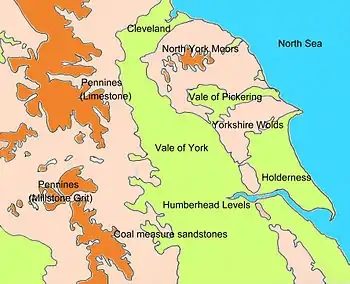Cleveland, England
Cleveland /ˈkliːvlənd/ is a land of hills and dales from the River Tees to Vale of Pickering, England. The name Cleveland comes from a variant of "cliff-land", referring to the Yorkshire Moors.

The land's historic borders include the county of Durham, North Sea, East Riding of Yorkshire and Allertonshire. Notable settlement in the land's north east lead to the term used as a synonym for Teesside and the area former covered by the Langbaurgh Wapentake. A non-metropolitan county under the same name formed from 1974-1996 under the name leading to ambiguity between the county and the full extent of the name.
Heritage
Cleveland has centuries-long association with the area from Middlesbrough to Pickering and Thirsk to Whitby, in affectively the eastern half of the North Riding of Yorkshire with central Allertonshire and western Richmondshire.
Ralph, Archdeacon of Cleveland, is first archdeacon of the area recorded, before 1174.[1] A Dukedom of Cleveland was first created in the 17th Century.
The Cleveland Hills, in the southern part of the district, were key suppliers of the ironstone that was essential to the running of the blast furnaces alongside the River Tees. Cleveland’s rich ore has created a significant industrial heritage arising from its central role in the 19th century iron boom that led to Middlesbrough growing from a hamlet into a major industrial town in only a matter of decades. Teesport is one of the United Kingdom's main ports, initially due to the iron boom, with between Middlesbrough and Redcar having other heavy industrial plants.
Name's usage
The Cleveland Parliamentary constituency (1885-1974), was the first instance of Cleveland referring to only land around the river Tees. The county of Cleveland and Tees Valley have followed on the same boundaries. The constituency was created by the division of the North Riding constituency, and was succeeded in name by the Cleveland and Whitby for the February 1974 general election.
The official name, from 1974, of the ”CLEVELAND” (TS postcode was formed from “TeeS“ or “Tees-Side”) postal county refers to a larger area including the non-metropolitan county and to the moors.[2]
Unlike multiple towns and cities in North America, Cleveland in Ohio is not named after its English namesake. This is commonly direct or via a toponymic surname. A notable usage of the area as a surname being Grover Cleveland, 22nd and 24th president of the USA.
Geographical features

The area is extremely varied geographically:
- Yorkshire Moors
- Howardian Hills
- Roseberry Topping: a distinctive hill. Its original roughly conical form was undercut by extensive mining, giving it a jagged appearance that many have thought reminiscent of the Matterhorn mountain.
- River Tees and east Teesdale
- River Esk
- Ryedale
- Vale of Pickering
Yorkshire Moors
Districts

- Hambleton (part)
- Middlesbrough
- Redcar and Cleveland
- Ryedale
- Stockton-on-Tees (south Tees)
- Scarborough
Titles
See also
- Cleveland Bay
- Cleveland Way
- Cleveland Bridge & Engineering Company, major structural engineering company.
- Cleveland Shopping Centre, Middlesbrough
References
- Greenaway, Diana E. (1999), Fasti Ecclesiae Anglicanae 1066–1300, 6, pp. 36–40
- Royal Mail, Address Management Guide Edition 4, (2004)